#Basic Concepts of Thermodynamics
Explore tagged Tumblr posts
Text
Shell and Tube Heat Exchanger Parts and Functions
#basic concepts#thermodynamics#allinfoche#chemical engineering#chemical engineer#HeatExchanger#HeatTransfer#shell and tube heat exchanger
0 notes
Note
HAI HAI!!
since your requests are open
I request:
Waitress!reader/waiter!reader x costumer!gojo
I love ur writing sm its fine if this one comes out late your kunafamily fics are enough to keep me happy for my entire life 💕
i decided to continue my nerd! gojo in the 90's au :)
gojo is cool. he's chill. he's definitely not about to make a total dweeb of himself in front of the most statistically, scientifically, gravitationally attractive human being he has ever laid his bespectacled eyes on.
you're just a waiter. a devastatingly good-looking, reality-breaking, hotter-than-a-bunsen-burner-on-max waiter. but whatever. he’s got this.
so when you set down his extra sweet caramel latte—because caffeine alone is for people who don’t respect the concept of joy—he decides, yeah, he’s gonna flex a little. “y’know,” he starts, adjusting his glasses like he’s about to drop some serious knowledge, “chemically speaking, caramelization is a non-enzymatic browning reaction caused by the pyrolysis of sugar at high temperatures, breaking it down into smaller volatile compounds that give off that totally radical smell and taste."
he glances up, hoping for at least a nod of interest, maybe a ‘whoa, dude, that’s fascinating’—but instead, you just blink at him.
danger. danger. abort. ABORT.
but then—you giggle. like, an actual, real life giggle.
oh. oh hell yeah. this is it. this is his moment.
he leans in, confidence skyrocketing. “basically, what i’m saying is, this latte? it’s got the same level of complex molecular interactions as the feeling of looking at your face.”
you snort. “that’s the nerdiest way anyone’s ever hit on me.” he shrugs, throwing in what he hopes is a suave smirk but probably just makes him look like he’s fighting a brain freeze. “i aim for innovation, babe. anybody can say ‘you’re pretty’—but only i can compare your existence to a maillard reaction.”
you shake your head, still grinning. “you really just monologued about sugar chemistry instead of just saying you think i’m cute, huh?”
“listen,” he says, leaning back and spreading his arms dramatically, “i could’ve gone with the basic approach, but then i’d be just some guy to you. i’m tryna be THE guy—the one you remember forever as ‘that one boy who equated my attractiveness to caramelization.’” you hum, tapping your chin. “that is pretty memorable.”
“right?! see, i’m playing 4D chess here.”
you roll your eyes but don’t stop smiling. “all right, textbook boy, enjoy your latte. try not to get lost in thermodynamic contemplation or whatever.” you walk away, and gojo, still riding the high of your giggles, takes a sip of his drink—only to immediately regret every decision he’s ever made in his life.
“holy—” he pulls the cup away, blinking rapidly. “that is so sweet. why did i order this?”
he hears you chuckle from behind the counter. he’s never ordering anything else ever again.
#@gojo#jjk headcanons#jujutsu kaisen headcanons#gojo headcanons#jjk x gender neutral reader#jjk x you#jjk x reader#jjk x y/n#jujutsu kaisen x gender neutral reader#jujutsu kaisen x you#jujutsu kaisen x reader#gojo satoru headcanons#satoru headcanons#gojo x you#gojo x y/n#gojo x reader#satoru x reader#satoru x you#satoru x y/n#gojo satoru x reader#gojo satoru x you#gojo satoru x y/n
291 notes
·
View notes
Text
Deeply fucking unsettling things about the Honored One himself, Satoru Gojo
Thanks to his ability to fuck with gravity, you put him in a blank, empty room with identical walls, floor, and ceiling with no doors or windows, he'll quickly lose track of which way is up. Realistically this situation would probably never happen, but the concept freaks him out ever since Geto made a joke about it once.
Gojo's body maintains a perfect thermodynamic equilibrium, making his skin creepily cool to the touch. He can go out in a blizzard with shorts on, and between that and Infinity, he'd be perfectly fine. It makes for a cool party trick, because he can stick his hand in a candle flame or put cigarettes out on his arms with no ill effects.
He's unsettlingly clean at all times, because dirt can't touch him. Gojo hasn't needed to use stain remover on his uniform in years.
He quite literally has six eyes. He keeps four of them shut and all of them hidden most of the time, though, because a) looking into all six at once would liquefy the brain of your average human, and b) his Six Eyes are constantly feeding unfathomable amounts of information into his brain every second. Even with his tolerance to his powers and mastery of the reverse curse technique, there's only so much stimuli a human brain can process without completely shutting down, and Gojo doesn't want to find out what that'll do to him--in a nutshell, just because he can see things that mankind can't even hope to comprehend doesn't mean he wants to.
He can perceive the entire electromagnetic spectrum, meaning he can see shrimp colors. Everyone else desperately wants him to describe the shrimp colors. Gojo continues to smugly refuse.
Because of his reverse curse technique constantly refreshing and regenerating his body, he just. doesn't really need to eat anymore. or drink. or even breathe. His body is basically frozen at peak physical condition, and it's very likely that he is functionally immortal.
Sometimes, Gojo forgets what pain feels like, because nothing can touch him. Pain feels almost like pleasure to him, because nothing can hurt him. Nothing can even touch him, and Gojo has secretly developed a perverted interest in seeing how badly he can mutilate himself before he's forced to reengage his technique and heal.
Gojo can bend and contort himself in ways that aren't humanly possible, run faster and farther and lift heavier objects than anyone alive, because his body can repair itself almost as fast as it's damaged, depending on how severe the injury. Basically, he has permanent hysterical strength, letting him push his body past its limits to perform feats that would kill a normal human with no ill effects.
Gojo doesn't sleep. He literally can't unless he releases his technique, because his body is constantly being refreshed and doesn't need to shut down. Oh well, it's for the better. He's most vulnerable while he's sleeping anyway, and it opens up his schedule by a lot.
His teeth grow now, almost like a rodent's. He has to file them down to be able to open and close his mouth properly, along with much more frequent trimming of his hair and nails.
His skin is oddly smooth, and unnaturally pristine. Gojo hasn't recieved a single scar since Toji sliced him open, and all the ones he'd recieved before are healed flawlessly at this point. His hands are so soft they make it look like he hasn't fought a day in his life, because calluses aren't able to form anymore.
Gojo's been around the world countless times now. He can go wherever he wants with a thought; the only cost is his sanity. Warping himself across the Pacific for lunch in San Francisco is fun, but he can only do it a few times a week if he doesn't want to have another... ah, episode.
These episodes involve blackouts, gaps in his memory where his powers manage to slip their leashes from overuse and literally short-circuit his brain. He's only had a few so far, and every time, he wakes up in the infirmary completely unscathed, with blood all over his clothes and an awful fucking migraine. Nobody knows what happens or where he goes, and all Shoko's been able to tell him is that when it happens, he seems to go into a giddy fugue before blasting his way out of the compound and vanishing for anywhere from days to weeks. Gojo's absolutely terrified of these episodes, because he's wholly aware that if he lost it for real, nobody would be able to stop him.
He looks human enough, but if you look closer, he quickly starts to set off the uncanny valley effect. It's like a wolf in sheep's clothing--because you know how dangerous he is, even though he appears relatively harmless at first. Everyone who meets him has the same fear response clawing at the back of their mind as their hindbrain screams at them to fucking run, because Gojo is an apex predator in the body of a prey animal. His very presence awakens primal fear that's been entrenched in every human since the dawn of time--the fear of things that go bump in the night, of cosmic horrors beyond what mankind can even hope to comprehend.
His eyes glow all the time now, and the energy crackling in the air around him feels like the static that comes before a lightning strike. Satoru Gojo is insistent that he's still human even though he's the strongest, but... is he, really?
#*chanting feverishly* eldritch horror gojo eldritch horror gojo#we need more gojo losing touch with his humanity and turning into a biblically accurate angel after the hidden inventory arc content guys#everything about this man is a perfect recipe for some good eldritch horror and my lovecraftian nightmare loving ass is going buck wild#i love me a deeply unhinged white haired man with legitimately horrifyingly unfathomable powers and a god complex#jujutsu kaisen#jujutsu gojo#jjk#gojo satoru#satoru gojo#headcanons#jacen writes#long post#cosmic horror
414 notes
·
View notes
Text
as a general maxim, when you make art you wanna create contrasts: detail vs simplicity, saturated colours vs grey, organic shapes vs inorganic, long paragraphs vs short, colloquial language vs formal, loud vs quiet, fullness vs emptiness
and you also want to work that on a meta level as well. contrasting between things being the same and things being different. repeating the same thing over and over feels homogeneous but so does everything constantly changing. a mix of some things coming back around and some things being novel keeps you guessing.
and keeps you guessing is an important thing - a purely regular pattern with no variation doesn't tend to elicit as much interest, except when it's placed in contrast to other artworks.
recently in the last few decades it seems that, probably inspired by the parallel discourses of machine learning, neuroscienctists have cooked up a kind of 'thermodynamics-style' theory of how the brain works with what they call the 'free energy principle', which casts the brain as being in a cycle of constantly generating predictions and testing them against sensory input in order to refine its internal model. here's artem kirsanov, a guy who makes pretty good videos on ML theory, with a neat visual summary:
youtube
why do they call it free energy? I guess they're following in the footsteps of Claude Shannon in borrowing names from thermodynamics for similar-looking formulae. (and in fact, Shannon entropy ends up playing a role here.)
I will need to dig more into this to really pierce the mathematical formalism and jargon in this hypothesis; presently I'm reacting to a surface summary and vibes. but musing on the idea, I think this tells quite a cute story about the above maxim for art: things that are hard to predict force us to do more work to develop our internal model, so they provoke us; but there does need to be something to predict, because it's also saisfying to resolve a pattern in the noise.
the interplay of surprise, recognition, and learning, by this theory, somehow drives how we feel about the art, from the feeling of intrigue when you see an intricate visual composition, to the emotional impact that comes from a long-teased resolution in music.
to add a wrinkle to this, apparently individual neurons respond positively to rhythmic stimulation, such that if you're trying to grow a physical neural net, that's how you 'reward' neurons for giving good outputs. (I believe it came up in this video where a youtuber tried to grow some neurons to play Doom.) repeated patterns are in a sense the 'least surprising' input. not 100% sure how that vibes with this theory tbh, I feel like there's a lot of ways you could fit those two concepts together.
music is a very 'pure' form of art in this sense: you establish clearly recognisable patterns and then vary them just before they start to get boring.
games, on the other hand, engage our direct interactive feedback: we can try things and see if the game responds in the way we expect, and in so doing, elaborate an internal model of the game world.
I think this also gives me a lens on my autistic difficulties with social interaction: until I learn enough of the social 'game' in a particular space to understand how the things I say are likely to be received, I tend to feel quite anxious. but once I start to get to know people and get a basic model and feel that I'm not likely to put my foot in it too badly, the feeling flips quite dramatically; it becomes exciting to meet people and learn about all the very specific things they're passionate about.
I don't wanna go too far with this, I distrust 'everything reduces to this simple formula' metaphors, but I formed a connection and now I'm telling you about it!!!
#introspective nightposting#philosophy#ai#not quite sure which of my existing boxes to put this subject in so it gets all three#neuroscience#Youtube
29 notes
·
View notes
Text
By popular (???) request, based on the outcome of this poll.
A WARNING: you guys really did pick the most complex one. This is loooooong. A DISCLAIMER. This is a silly little lesson aimed at folks who know sod-all about MRI. There are memes. There is (arguably) overuse of the term ‘big chungus’. If you are looking to delve deeper into the mysteries of K-Space, this is not the Tumblr post for you.
So, without further ado...
Today I am introducing you to my one true love. The legend. The icon.
Ferromagnetic material loves him. Claustrophobic people fear him.
Yeah, that’s right – we’re talking about the big boom-boom sexyboy magnet machine, hereby known as Big Chungus.

Aka...
MAGNETIC RESONANCE IMAGING
First off, though? Let’s start small.
Very, very small.
Meet HYDROGEN.

The nucleus of this element is made up of a single proton, which has a magnetic dipole – i.e., it acts like a tiny bar magnet.
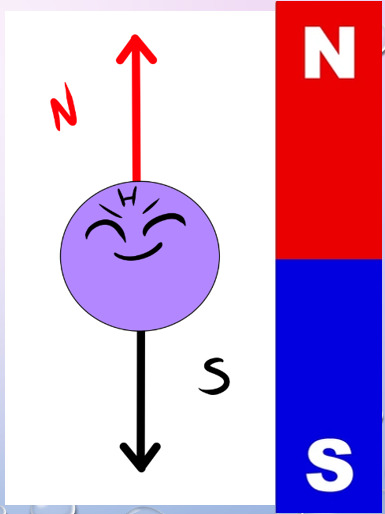
Hydrogen is also a component of water. As we all know, we’re basically walking sacks of goop – meaning that Hydrogen is abundant throughout our bodies.
Therefore, when we stick you in a strong magnetic field… say, within our friend Big Chungus… we can manipulate all those tiny Hydrogen atoms in a variety of fun ways.

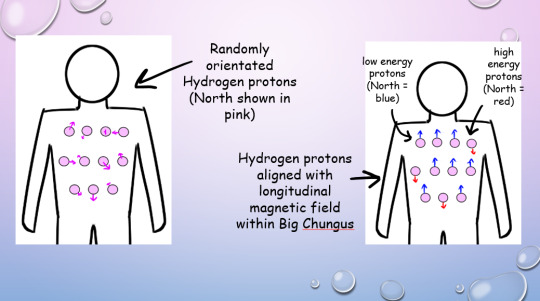
Under normal conditions, all your Hydrogen protons are pointing every-which-way.
But in Big Chungus, there is a strong longitudinal magnetic field that travels along the Z-axis of the machine. So, all your teeny tiny Hydrogen protons swivel to align with that field!
If a proton’s energy is LOWER than that of the longitudinal magnetic field (a majority), they will align PARALLEL with the field. If their energy is HIGHER (a minority) they will align ANTI-PARALLEL.
As most of the protons align with the longitudinal magnetic field, the net magnetisation vector within the human body is also longitudinal! This is called the thermodynamic equilibrium – the resting state for all those li’l protons when your body is within Big Chungus.
(You won’t feel any different, btw! We’re flipping a bunch of teeny-tiny bits inside you, but you won’t feel a thing!) (You might do later, when we activate the Gradient coils. We’ll….. get to that)
But, while all of this is very cool, it gives us no actual information. We gotta play some more with your protons - which brings us to arguably the most important concept in MRI. I mean, it’s literally in the name!

Let’s go back to our Hydrogen protons.

We’ve established that they’re all pointing in different directions. But they’re not just sitting still. They’re spinning and wobbling all over the shop.
We call this rotational wobbly movement precession.
In their natural state, these protons all precess at different speeds. When we subject them to Big Chungus, as well as all lining up neatly with the magnetic field, they all start to precess at the same speed.
However, their magnetic North will be pointing to different points at any given moment. Imagine two clocks, both of which are ticking at the same rate, but which have been set to read different times.
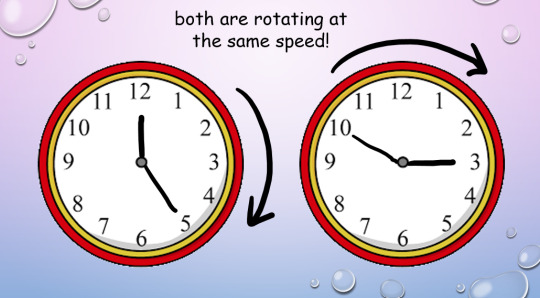
This is where magnetic resonance comes in.
In addition to the homogenous longitudinal magnetic field provided by Big Chungus, we also create an oscillating magnetic field in the transverse plane by using a radiofrequency (RF) pulse. We can tune that oscillation to the ‘resonant frequency’ of Hydrogen atoms.
Every molecule capable of resonance has its own specific frequency. We use a funky equation called the Larmor Equation to work this out, or, as I like to call it, W, BOY!!!
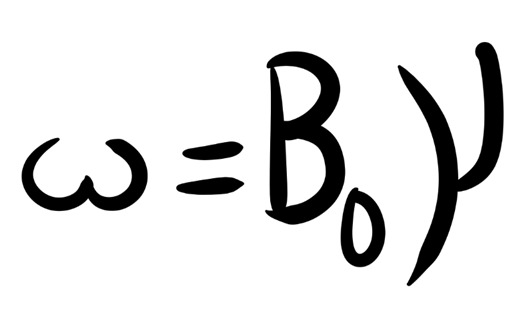
(The weird ‘w’ is the resonance frequency; the weird ‘Bo’ is the magnetic field strength, and the weird ‘Y’ is the gyromagnetic ratio of each particular element.)
So, we know exactly at what frequency to apply that RF pulse to your protons, to achieve resonance!
But what is resonance?
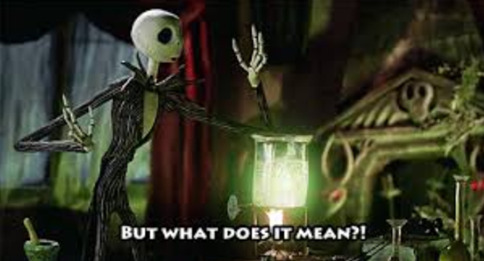
In acoustics, a ‘resonant frequency’ is the frequency an external wave needs to be applied at in order to create the maximum amplitude of vibrations within the object. Like when opera singers shatter glass with their voice! They’re singing at the resonant frequency of the glass, which makes it vibrate to the point where it compromises its structural integrity.
A similar concept applies in magnetic precession, with, uh, less destructive results. We’re not exploding anything inside of you, don’t worry!
(We do explode your innards accidentally in Ultrasound sometimes, via a different mechanism. But you’ll have to ask me more about that later. >:3)
To put it simply, magnetic resonance is the final step in getting those protons to BEHAVE. Now, the clocks have been corrected so their hands move at exactly the same time, in the same position. The protons are precessing ‘in phase’. Yay!
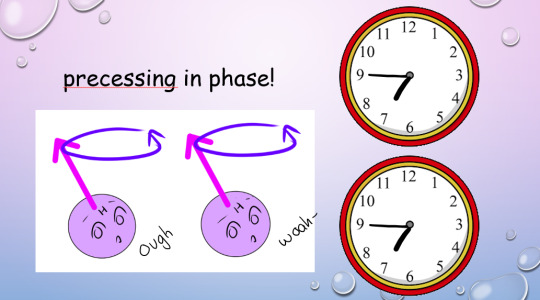
This creates transverse magnetisation, as the magnetic vectors of all those protons (which, remember, act as bar magnets) will swing around to point in one direction at the same time.
But the cool thing about resonance? It also allows the protons to absorb energy from the RF pulse.
(Do NOT ask me how. Do NOT. I will cry.)
And remember how the higher-energy protons flip anti-parallel to the longitudinal magnetic vector of Big Chungus, while the lower-energy protons are aligned parallel? And because we have more low-energy protons than high-energy protons, our body gains a longitudinal magnetic vector to match Big Chungus?
Zapping those protons at their resonant frequency gives 'em energy (a process known as ‘excitation’, which I love, because I get to imagine them putting little party hats on and having a rave).
So, loads of them flip anti-parallel! Enough to cancel out the net longitudinal magnetic vector of our bodies – despite the best efforts of good ol’ Chungus!
(Keep trying, Chungus. We love you.)

Our protons are as far from our happy equilibrium as they can possibly be. We’ve lost longitudinal magnetisation, and gained transverse magnetisation. Oh noooo however can we fix this ohhhh noooooo
Simple. We turn off the RF pulse.
Everything returns to that sweet, sweet thermodynamic equilibrium.
Longitudinal magnetisation is regained. I.e., the protons realign with Big Chungus’s longitudinal magnetic field, with the majority aligned parallel rather than anti-parallel.
This is called SPIN-LATTICE RELAXATION.
‘T1 time’ is the point by which 63% of longitudinal magnetisation has been regained after application of the RF pulse. A T1-weighted image shows the difference between T1 relaxation times of different tissues.
And, without that oscillating RF pulse, we lose resonance – the protons fall out of phase randomly, due to the delightful unpredictable nature of entropy, and Transverse magnetisation reduces.
This is called SPIN-SPIN RELAXATION.
Or, if we’re feeling dramatic…

‘T2 time’ is the point by which 37% of the transverse magnetisation has been lost. A T2-weighted image shows the difference between T2 relaxation times of different tissues.
(Spin-spin is objectively a hilarious phrase to say in full seriousness when surrounded by important physics-y people. However, a word to the wise: do not make a moon-moon joke. They are not on Tumblr (present company excluded). They will not understand. You will get strange looks.)

But remember how resonance lets our protons shlorp up that sweet, sweet energy from the RF pulse? Well, in order to get back to thermodynamic equilibrium and line up with Big Chungus again, they have to splort that energy back out.
This is why we stick a cage over the body part we’re imaging. That cage isn’t a magnet, or a way of keeping you still – it’s a receiver coil.
It picks up the RF signal that’s given off by your innards as they relax from the intense work-out we just put them through. How cool is that??

The amount of time we wait between applying the RF pulse and measuring the ‘echo’ from within your body is called the ‘ECHO TIME’, or ‘TE’ (because we didn’t want to call it ET).
(yes, we’re cowards. Sorry.)
We also have ‘REPETITION TIME’ or ‘TR’ – the amount of time we leave between RF pulses! This determines how much longitudinal magnetisation can recover between each pulse.

By manipulating TE and TR, we can alter the contrast (i.e., the blacks and whites) on our image.
Areas of high received signal (hyperintense) are shown as white, while areas of low received signal (hypointense) are shown as black. Different sorts of tissue will have different ratios of Hydrogen-to-other-shit, and different densities of Hydrogen-and-other-shit – ergo, some tissue blasts out all of its stored energy SUPER QUICK. Others give it off slower.
A T1-weighted image has a short TR and TE time.
Fat realigns its longitudinal magnetisation with Big Chungus SUPER QUICK. This means, on a T1-weighted image, it looks hyperintense. However, water realigns its longitudinal magnetisation with Big Chungus slooooowly. Therefore, on a T1-weighted image, fluid looks hypointense! Ya see?

A T2-weighted image has a long TR and TE time.
The precession of protons in fat decays relatively slow, so it will look quite bright on a T2-scan. But water decays slower, and therefore, by the time we take the T2 image, fluids within the body will be giving off comparatively ‘more’ signal than fat – meaning they’ll appear more hyperintense!
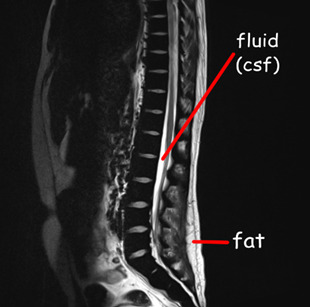
If we have a substance with intrinsically long T1 and T2 values, it will appear dark on a T1-weighted image and bright on a T2-weighted image, and the same in reverse. If a substance has a short T1 value and a long T2 value, it will appear relatively ‘bright’ on both T1 and T2-weighted images – i.e., fat and intervertebral discs.
As every tissue has its own distinct T1 and T2 property… we can work out precisely what sort of tissue we’re looking at.
When we build in all our additional sequences, this becomes even clearer! This is why your MRI scan takes sooooo long – we’re running SO MANY sequences, manipulating TR and TE to determine the exact T1 and T2 properties of various tissues within your bod.


There is, however, a problem.
The RF signal given off by each proton doesn’t shoot out in a handy-dandy straight line. Meaning, we have no idea where the signal is coming from within your body.
Enter our lord and saviour:
THE GRADIENT COILS.
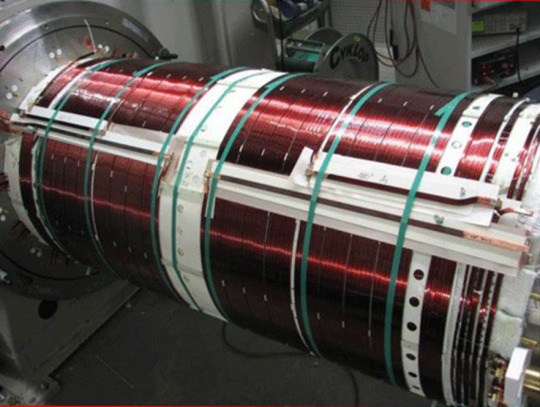
(Shim coils are also very important – they maintain field homogeneity across the whole of Big Chungus. While Big Chungus wouldn’t need them in a perfect theoretical scenario… reality ain’t that. Big Chungus’s magnetic field is all wibbly-wobbly, so we use Shims to keep everything smooth! That’s all you need to know about them. BACK TO THE GRADIENTS.)
There are three of them, wrapping around each of the three planes of your body. When these activate, they cause those epicly eerie booming noises, characteristic of a Big Chungus ExperienceTM.
youtube
The Gradient coils are also what causes those weird tingling sensations you get in an MRI machine – which, don’t worry, aren’t permanent! Your nerves just go ‘WOAHG. THASSALOT OF MAGNET SHIT. HM. DON’T LIKE THAT.’ But they’ll calm down again once you’re freed from Big Chungus.
The gradient coils cause constant fluctuations in the magnetic field across all three dimensions. They activate sequentially, isolating one chunk of your body after the next.
As these fluctuations cause variation within the signal received, we can look at how much THAT particular signal, received at THAT particular number of milliseconds after an RF pulse, varied when THAT particular gradient was activated, in comparison to when THAT OTHER gradient was activated.
For every single bit of signal output.
That gives us A WHOLE LOTTA DATA.

^ imagine this, but the cupboard contents is just. data.
Way too much data, in fact, for our puny human brains to comprehend – so obviously, we feed it to an algorithm.
K-space is a funky computational matrix where all this info gets compiled during data acquisition. Once we’ve finished the scan sequence and have all that yummy raw data, it can be mathematically processed to create a final image!
Just like that. Simple, right?

TL;DR
You are full of Hydrogen.
Hydrogen nuclei (protons) are basically tiny magnets
These tiny magnets are orientated completely randomly, with ‘North’ pointing in all directions
We stick billions of these tiny magnets (i.e., you) into a mahoosive magnet (i.e., Big Chungus)
All the tiny magnets flip around to align with the longitudinal magnetic field of Big Chungus
High energy protons = antiparallel Low energy protons = parallel
As you have more low energy protons than high energy protons in your body, the net magnetic vector of your body is longitudinal – just like Big Chungus!
All your protons are spinning and wobbling (precessing) at random rates
We use an RF pulse, tuned to the Resonance Frequency of Hydrogen, to make ‘em precess in phase (wobble at the same time, all pointing in the same direction at once). This creates a Transverse magnetic vector.
This in-phase precession is ‘Magnetic Resonance’
Magnetic Resonance means the protons can absorb energy from the RF pulse
Now there are more high energy protons within your body! They flip antiparallel, and the net longitudinal magnetic vector of your body decreases.
We measure the time it takes for the high-energy protons to release that energy and return to alignment with the net magnetic vector of Big Chungus (Spin-Lattice Relaxation / T1 recovery)
And the time it takes for the precessing-in-phase protons to Quit That Nonsense and all start wobbling in random directions again (Spin-Spin Decay / T2 recovery)
Each tissue within your body has a different composition & density of Hydrogen atoms – which means each tissue within your body has a unique T1 & T2 recovery time
By measuring the signal at different times (TE) and by varying the frequency with which we apply RF pulses (TR), we ‘take pictures’ that show variations in the amount of signal these tissues are giving off. The signal is caught by the large radiofrequency receiver coils we put over you when you enter the machine.
Because the signal given off during recovery/decay blasts out in all directions, we don’t know exactly where it originated within your body.
Gradient coils are arranged across X, Y, and Z axes throughout the gantry of Big Chungus. They cause tiny fluctuations in the magnetic field, in sequential chunks throughout space. This is the booming noise you hear when you’re in the machine.
These tiny fluctuations cause variations in the signal we receive, depending on how close the signal is to the activated gradient coil. All this data is compiled in a magical computational matrix called K-space. A funky algorithm then decodes those variations and couples them up with the strength of the signal to give us 1) How much signal is being blasted out at that particular moment 2) Where exactly that signal comes from within your body, according to the 3D map produced by the gradient coils
It then represents these values with a pretty picture!
Tl;dr tl;dr:

78 notes
·
View notes
Text
thinking again about a rwby AU concept where we actually like go further into animals being able to have Aura and how hugely important this actually could be if you think harder about it also i want there to be straight up fantasy creatures besides Grimm because not only does that strengthen the fairytale world half of the vibe, but think about it. having active Aura is basically a biology cheat code, especially if you evolve so that it's nearly guaranteed (Which I imagine is actually pretty damn hard in a way that prevents active Aura from being the no-brainer killer app, because it turns out *anything* with it becomes a target for Grimm. *And* it has some resource and development speed downsides at first, until a species sticks with it enough to make it efficient and "self-repaying", essentially.) You get to evolve way weirder because you can just straight up use your soul to have a limited degree of being able to tell entropy itself to fuck off. Aka Non-Grimm dragons, sea monsters, fairies, slimes, giant bugs, shapeshifting foxes, sauropod dinosaurs, bigfoot, giant sandworms, whatever the fuck, all can "logically" be real And on the more mundane side... Aura pigeons, aura horses, and aura dogs are probably the three literal most importantest animals AYYYVER, often to the point it borders on, or flat out is worship, because civilization was literally impossible without them, and many argue it would in fact still be impossible without them. Dragons are really cool and all, but these just always tended to be so straightforward and simple that it made them a lot more *practical* Not even the no emotions laws could bring themselves to be so ghoulishly strict and draconian as to not let people work with and potentially secretly love these animals. It was just too obvious that it would be *wildly inefficient* and *wildly unsafe* Being mean to pigeons is seen as the same shorthand for a horrific person as being mean to a puppy (and has a bleed-over effect to species that people *know* do not develop Aura, as not only does it still feel viscerally *wrong*, they have a niche as something Grimm usually ignore.) And to the point that a starving, stranded hunter with just his partner dog would literally rather let the dog eat him, and every society can agree that yes, this is exactly what you should do, and anyone with a soul should agree that if this happens the other way around, that is an abomination on par with baby-eating. The pigeons in a given city are not even actually "feral", they are each about as smart as an elementary school kid and more like everyone's collective "friends" and "honorary citizens", with a lot of people even going so far as to think its a little fucked up and mean to call them "pets", and literally even the Schnee Dust Company has willingly dialed back their pollution and sunk tons of money into air filtration Because not even *Jacques* is cartoonishly *wretched* enough to want to harm the lungs of the pigeons, even knowing that they can tolerate it better because of their Aura's passive healing, as nobody wants them wasting it on something avoidable when they're so *important*: Having them everywhere means that they are an insanely good early warning, alert, and scouting system against Grimm, and importantly, one that does not give a shit about your power and communication grids going fuckywucky, as is terrifyingly likely when a lot of Grimm show worrying signs that they might actually be *learning how to target that stuff*, or at least are sensitive to EM fields. Even in peace, people use them as living GPS navs and merchant companions and living "good luck charms" for any kind of journey out of a city in general. (they do not literally have good luck. people just think so) On the more ruthlessly pragmatic side, though, aura chickens are also incredibly important. For a simple reason: The power to make thermodynamics go kinda fucky + increased regen and hardiness = holy hell. you're an infinite meat glitch!!! (no, still not literally though- it has limits)
12 notes
·
View notes
Note
Ok, after your most recent rev log post about WIP’s I HAVE to ask the concepts for: The Ridiculous Fic, Dragon Dance, and Lawyer Azula x Biomarine doctor Sokka
Ask and you shall receive!
Under the cut, cause I talk too much:
The Ridiculous Fic: Post canon Sokkla
The previous title used to be 'Sokka is a nerd and Azula is horny'. No plot, just vibes and crack smut. Here's a snippet:
There was just so much she could take.
"Fine!" she shouted, jumping out of her seat with an uncharacteristic lack of dignity. "I will fuck you, you can cease with that flirting and dirty talking."
Sokka's tools almost fell out of his hands as he watched Azula hastily undo her robes.
"Um…" was the most eloquent answer he could offer, but it was enough to stop her for a moment, and for that, Sokka was grateful, even though the way her clothing was falling off one shoulder allowed for not much to be hidden off the left side of her chest.
He set his tools down slowly, trying to gather his bearings. "I am not saying no. But uh…I was just talking about how the application of thermodynamics increases the functionality of the new proper system for the latest design for airship travelling?"
Azula moaned.
Dragon Dance: Post canon Sokkla
10+ years after the end of the show, Republic City Councilman/Ambassador Sokka, while in the Fire Nation and exhausted from Everything ™, decides to dump his military escort, go to a town and drink himself to a stupor high enough to distract him from said Everything ™. The best place in the random town he is in, according to the locals, is this establishment that also has shows, not only drinks. And Sokka is like sure, whatever, let's go. The place is PACKED, all tables are taken, people are lined up against the walls, on the floor. Here for the show they say. And there is a chance Nariden might make a surprise appearance. Those words mean nothing to Sokka, so he just orders a drink while leaning against a column. The show is interesting. They aren't just dancing, they are Fire Dancing, using the bending as a prop/part of the routine etc. Sokka is far more interested in the drinks, though, cause the drinks are amazing. Then it seems like the show is over, but then there's a surprise appearance and the whole place loses their minds cause Nariden did indeed make an appearance and Sokka understands why the place is so crowded. The dancer IS amazing. And maybe it was just the alcohol but despite her wearing a mask, Sokka has a vague feeling he knew her from somewhere.
Now with fire dancer Azula, who grew up, healed, and has positive influences in her life. Oh, there's also a secret society that worked towards preserving traditional/pre-war firebending throughout the past century but that's like in the background. I am considering making this a two-parter, with the second part being Dance Teacher Azula in Republic City.
Lawyer Azula x Biomarine doctor Sokka: Modern AU
Azula is a lawyer who ends up being hired to evaluate the legality of a property and business in SWT. Said business is an Oceanarium, working with rescuing and treating marine life. They are particularly known for making prosthetics for disabled animals like dolphins and whales etc. (yes, that's Sokka's work). When she goes to inspect the place, Sokka shows up and basically shouts at her to get off his lawn. Shenanigans ensue.
There is an evil corporation trying to take over the land in the background, Azula being a badass who you should not mess with, grumpy Sokka who is writing his second PhD thesis in the notes app on his phone, Azula trying ice swimming, her and Sokka arguing like an old married couple and Hakoda and Bumi II in the background taking bets on how long until these two get together
10 notes
·
View notes
Text
I'm curious as to peoples idea for what he'd do for the next power hour so
[These all being popular ideas or ppl he's mentioned]
This was all just a ploy to get you to read my info dump theory on the concept of a Chonny Jash Power Hour loser HAHAHA
Im joking tho. Not about my CJPH theory, that is very much real but I'm not forcing you to read it lol
However if you're curious, my inane rambles are further down :}
[Long Rant Post Below]
Okay so I'm gonna start with the basic idea I got it from; that being Nerd. Nerd already foreshadowed the THDPH & the WWPH [Even down to the last song for each of them] Not only that, but he references the stuff hes done in the past as well with a break/pause inbetween.
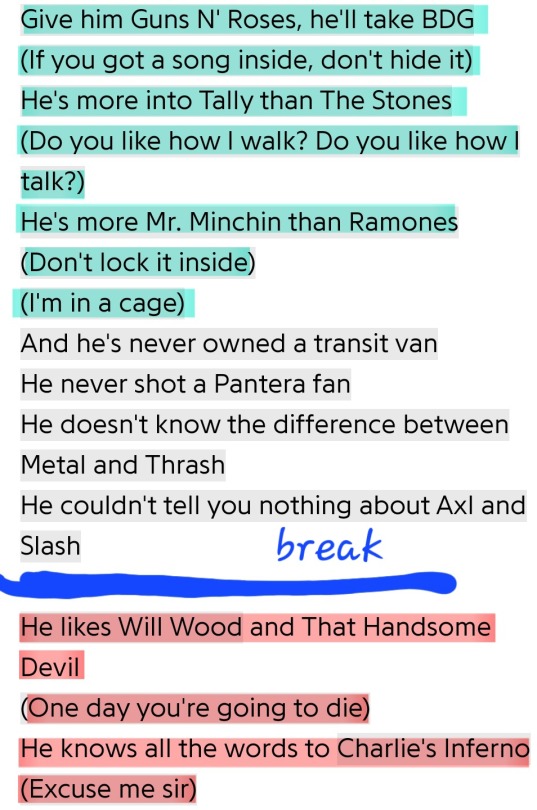
[This is what I mean]
The first three being all stuff he already did. BDG with Pocket, Tally Hall with Vol.1 & then Cage by Tim Minchin being the start the power hours.
The next two being the power hours he would do after this song [Memento Mori & Charlie's Inferno-Will Wood & That Handsome Devil]. But those are the only songs he would reference in Nerd, leaving no more clues as to what the last one would be. The only thing left in it is the video game references & Stairway to Heaven in the ending. [Which oddly enough also fit the pattern in a way. StH being about dying and the afterlife like Memento Mori & Chonny's Inferno and the video game references being all covers he made on his old channel]
While the VG refs could be a hint at a Videogame or Toby Fox Power Hour, I think at most, if its a clue at all, hinting at the next thing he does is recovering old songs.
----
Next, a couple of his songs reference his past stuff. Fine, I'm Fine has a good amount of lines that vaguely refer back to songs from the before [heres a post that goes more into it that's pretty cool!!]. And more importantly Dear Machine references Pocket, Dream (Outro from Calamity) & wings of wax. Pocket being later used in Nerd & the mention of Icarus coming back in Art. Not only that, but the voice in the very end Thermodynamic Lawyer is the exact same [if not very close to] voice filter/effect he uses in Dear Machine. Even down to the British accent he does in it. [Tho it is fairly normal for a music artist to reference their older songs in their music so it could be nothing]
Speaking of Dear Machine tho, quick thing to add about it is that it shows he not against covering his own songs. While yea technically its just a different version of Ode of the Cog, DM,HtC in a way counts as a cover of OotC. Same goes for bargaining/compromise & The Ballad of Dr. Jekyll.
----
Another idea with a CJPH is that in the CJFS discord theres a "Question of the Day" Channel. Where, as the name says, a Mod or Helper will ask a CJ related question & everyone can give their idea/imput on it. For Day 100, as a special fun lil thing, they asked Chonny if he wanted to give a question for that day. His question being:


And yes he does say that he doesnt plan on doing anything like that in future [if he even were to do it]. I fully believe he wasn't lying there & honestly I never saw him redoing any song ever until I had the idea of a CJPH [aside from stuff like Spring and a Storm & Storm and a Spring obviously]. But this is the best idea I could ever see him doing that. Also that question was from early August so a fair amount of time has passed. Whether thats enough time to equal "at least in the near future at all" I have no clue, but it is a thought.
----
One of my last points [that I remember atm lol] is on how he would end the power hours. Cos like, while yea he does whatever he wants & doesn't rlly follow what anyone says or asks [which I 100% agree with & is completely valid btw], I'd imagine he'd still want to end the PHs with a bang. Which is why I originally didnt think the recent one would be Will Wood.
He's stated a couple of time that hes one of his favorite artist & he definitely knows that a huge chunk of his fan base listen to WW as well. So why not end with that? Why not end with one of the most requested artist people wanted him to cover? Why wouldn't he end with a power hour of the artist that was his #1 on his Spotify Wrapped? What else could he do after that? Well maybe he'd go with his #2 artist? WHICH IS JUST HIMSELF BBYYYY

Plus, the name Power Hour already comes from this:

So it's very likely he's had himself play multiple times in a row & had a "Chonny Jash Power Hour".
Of course theories are just theories so there's always the chance I'm wrong & just insane. And again he does whatever he wants whenever he wants so who knows what it'll be. I just think id be an interesting idea for him to do.
As for how a Chonny Jash Power Hour would look? Maybe each song being a cover of a song from a past album or single? I'd imagine one from the before. & Covered in Discontent [maybe Gothic Whore?]. Like remake Pocket since its been referenced so much, tho that's still just a BDG cover so who knows. the before. would be interesting just to see how his perspective has changed since he originally wrote those songs. Gothic Whore he already has 2 songs that have a story version & a him version so I can see him doing another.
I HIGHLY doubt he'd do anything related to Vol.1 as its his completely separate thing & he doesn't rlly wanna touch any song that's TH/HMS related until whenever he feels like starting Vol.2 [which is valid lol]. If anything I could maybe see like TWWAY, Special or maybe Greener? Or go a different route with the og I'm Gonna Win or like a more outta the box one with like Just a Friend [only cos be did a 20 second "cover" of it in Mucka Blucka]. Again, I do not see him touching anything Vol.1 related but still something to entertain ig? [4th TME cover; The Chonny Electric when/j]
Tho maybe he'd just remake songs that he he fully made [like the before. or Gothic Whore], since those are more of actual Chonny Jash songs rather than the others just being covers. Would be very cool to maybe see a remake of some of his Majora's Mask song tho [no this isn't me coping over HEAL not being on spotify shush]. Or maybe he'd do songs from his old stuff like Don't Take it Personally? [also not me coping over wanting that song on Spotify too]
Idk these are just my thoughts on the idea of a CJPH [or even a Can of Soup Power Hour/j]. Either way I am gonna say idc what he'd do, BDG or Streetlight Manifesto are my other guesses, but anything he makes is always rll good & fun so I'll be interested to see whatever it is.
But ya know considering I typed all this out in the span of an hour & a half I kinda hope im not wrong PFFT
#apologies if there's any grammar or spelling mistakes lol#i just typed a lotta insane ramblings so im bound to mess up somewhere. also i am dyslexic#if you actually managed to read all that. Congrats & thank you :D! Also why tho! you're insane for listening to me being insane/j#I hope I made sense at least#And if you spent any time even glancing at my text thank you a lot but I hope you aren't bored lol#also its still gonna be a bit since he does a power hour but still curious as to ppls ideas of it#at least it BETTER be awhile. bro better take that damn br8k#chonny jash#moss post#KJ is going insane again
73 notes
·
View notes
Note
What subjects are actually taught at the academy? I've heard of recreational mathematics, thermodynamics, and touch telepathy, but what other courses are there?
What subjects do young Gallifreyans and Time Lords learn?
For once, we can be very very detailed about this!
🔬 Fundamental and Advanced Sciences
Quantum Mechanics: Introduced early in Gallifreyan education, this subject uses multidimensional geometry to solve complex problems, exploring the interplay between abstract concepts and physical realities.
Thermodynamics: This subject explores the principles of energy conversion between heat and other forms of energy, crucial for understanding the energetic dynamics of time-travel technology.
Cybernetics: Focuses on the study and construction of systems with regulatory functions, integrating technological and biological processes for the creation and maintenance of cybernetic beings and advanced machinery.
Matrix Diagnostics: Covers the techniques and tools used for diagnosing and maintaining the Matrix, a vast repository of Time Lord knowledge and consciousness.
⏲️ Specialised Temporal Studies
Basic Temporal Theory: Introduces the concepts of time and its properties, laying the groundwork for more advanced temporal manipulation studies.
Advanced Temporal Theory: Offered to students with intellectual perseverance, diving deeper into complex temporal phenomena and manipulation techniques.
Temporal Engineering: Encompasses engineering principles to temporal mechanics, essential for practical time manipulation.
TT Capsule Construction and Design: Focuses on the design and construction techniques specific to Time Travel Capsules, integrating advanced dimensional engineering and Veteran and Vintage Timeships.
TT Capsule Operation and Maintenance: Includes Space-Time Navigation, covering the operational aspects and routine maintenance of TARDISes.
Engineering Theory: The study of spaceship construction in general from different cultures.
Stellar Engineering and Cosmic Science: Deals with the manipulation and understanding of cosmic phenomena.
Dimensional Science: Studies the properties and manipulation of various dimensions beyond the standard three-dimensional space.
Dimensional Engineering: Applies engineering principles to manipulate and control various dimensions for practical uses.
Spatial Cartography: Teaches the mapping of space and the intricate layers of multiple dimensions.
Temporal Protocol and The Laws of Time: Ensures that all actions taken by Time Lords are in accordance with Gallifreyan law and temporal ethics.
Temporal Classics: Studies classic temporal theories and their applications through history.
🧠 Psychic and Telepathic Disciplines
Touch Telepathy: Teaches advanced communication techniques using innate psychic abilities.
Telepathic Defence: Includes mind-shielding techniques to protect students from psychic intrusions.
Psychic Field Manipulation: Standard training that covers manipulating one's psychic environment, including the science of Temporal Stasis.
🎨 Arts and General Studies
Super-logic: A complex form of logic used to solve problems that are beyond traditional logical frameworks.
Recreational Mathematics: This probably includes the study of happy prime numbers and other 'fun' maths (is there such a thing?), blending leisure with learning.
Art: Covers various forms of Gallifreyan art, including the creation and study of stasis cube art.
Gallifreyan History: Covers Gallifrey's past, including studying cosmic influences like those of the Assyrians.
Future History: Involves the study of fixed points in history, such as the Cro-magnon period on Earth.
Vector Justice: Teaches the principles of fairness and justice as practised by the ancient organisation known as the Vectors.
Botany and Biology: This field covers the study of Gallifreyan and alien plant and animal life, incorporating advanced biophysical studies.
Medicine: Includes tri-bio-physics and other medical sciences.
Languages: Teaches the linguistic skills necessary to communicate across thousands of different languages.
Music: Explores musical theory and practice, including the traditional harp lessons.
Detachment and Physical Inactivity: Focuses on mental and physical disciplines required to maintain objectivity and calm in all situations.
📚 The Culture of Learning
The Academy isn't just about academic achievement but also about instilling a deep-seated ethos of service and responsibility towards time and the wider universe. It's complemented by:
The Codex of Disciplines: A guide to the ethical and practical aspects of time travel and interaction with both time and the multitude of species across the universe.
Competitive and Collaborative Learning: From zero-gravity hyperball teams to Academy Sprint Championships, Time Lords are encouraged to excel in both individual and team endeavours.
Related:
💬|🧸🏫How is sexual education taught on Gallifrey?: How Time Tots might get taught about sex.
💬|🧸🏫How do grade levels work in Gallifreyan schooling?: How the Gallifreyan education system works.
💬|🧸🧑💻What are Gallifreyan teenagers like?: Talking about the strange world of Gallifreyan adolescence.
Hope that helped! 😃
Any orange text is educated guesswork or theoretical. More content ... →📫Got a question? | 📚Complete list of Q+A and factoids →📢Announcements |🩻Biology |🗨️Language |🕰️Throwbacks |🤓Facts → Features:⭐Guest Posts | 🍜Chomp Chomp with Myishu →🫀Gallifreyan Anatomy and Physiology Guide (pending) →⚕️Gallifreyan Emergency Medicine Guides →📝Source list (WIP) →📜Masterpost If you're finding your happy place in this part of the internet, feel free to buy a coffee to help keep our exhausted human conscious. She works full-time in medicine and is so very tired 😴
#doctor who#gil#gallifrey institute for learning#dr who#dw eu#gallifrey#gallifreyans#ask answered#whoniverse#GIL: Asks#gallifreyan culture#gallifreyan lore#gallifreyan society#GIL: Gallifrey/Culture and Society#GIL: Species/Gallifreyans
40 notes
·
View notes
Text

Even quantum physics obeys the law of entropy
Is there a contradiction between quantum theory and thermodynamics? On the surface, yes - but at TU Wien, researchers have now shown how the two fit together perfectly
It is one of the most important laws of nature that we know: The famous second law of thermodynamics says that the world gets more and more disordered, when random chance is at play. Or, to put it more precisely: That entropy must increase in every closed system. Ordered structures lose their order, regular ice crystals turn into water, porcelain vases are broken up into shards. At first glance, however, quantum physics does not really seem to adhere to this rule: Mathematically speaking, entropy in quantum systems always remains the same.
A research team at TU Wien has now taken a closer look at this apparent contradiction and has been able to show: It depends on what kind of entropy you look at. If you define the concept of entropy in a way that it compatible with the basic ideas of quantum physics, then there is no longer any contradiction between quantum physics and thermodynamics. Entropy also increases in initially ordered quantum systems until it reaches a final state of disorder.
Entropy and the direction of time
Equating ‘entropy’ with ‘disorder’ is not entirely correct. After all, what you understand by ‘disorder’ may be subjective, but entropy can be clearly defined with mathematical equations.
“Entropy is a measure of whether a system is in a special, very particular state, in which case the system has low entropy, or whether it is in one of many states that look more or less the same, in which case it has high entropy,” explains Prof Marcus Huber from the Institute for Atomic and Subatomic Physics at TU Wien. If you start with a very specific state, for example a box full of balls that are sorted exactly by colour, then if you shake the box a little, a higher entropy mixed state will develop over time. This is simply due to the fact that only a few ordered states exist, but many that are similarly disordered.
“From a physical point of view, this is what defines the direction of time,” says Max Lock (TU Wien). “In the past, entropy was lower; the future is where entropy is higher.” However, quantum physics encounters a problem here: the mathematician and physicist John von Neumann was able to show: according to the laws of quantum physics, the entropy in a quantum system cannot change at all. If you have the full information about a quantum system, the so-called ‘von Neumann entropy’ always stays the same; it is impossible to say whether time is running forwards or backwards, each point in time is physically as good as any other.
We only ever know part of the information
“But this view leaves out something important,” says Tom Rivlin (TU Vienna). "In quantum physics you can never actually have full information about a system. We can choose a property of the system that we want to measure – a so-called observable. This can be, for example, the location of a particle or its speed. Quantum theory then tells us the probabilities to obtain different possible measurement results. But according to quantum theory, we can never have full information about the system."
Even if we know the probabilities, the actual result of a specific measurement remains a surprise. This element of surprise must be included in the definition of entropy. Instead of calculating the von Neumann entropy for the complete quantum state of the entire system, you could calculate an entropy for a specific observable. The former would not change with time, but the latter might.
This type of entropy is called ‘Shannon entropy’. It depends on the probabilities with which different possible values are measured. ‘You could say that Shannon entropy is a measure of how much information you gain from the measurement,’ says Florian Meier (TU Wien). "If there is only one possible measurement result that occurs with 100% certainty, then the Shannon entropy is zero. You won't be surprised by the result, you won't learn anything from it. If there are many possible values with similarly large probabilities, then the Shannon entropy is large."
Quantum disorder increases after all
The research team has now been able to show that if you start with a state of low Shannon entropy, then this kind of entropy increases in a closed quantum system until it levels off around a maximum value – exactly as is known from thermodynamics in classical systems. The more time passes, the more unclear the measurement results become and the greater the surprise that can be experienced when observing. This has now been proven mathematically and also confirmed by computer simulations that describe the behaviour of several interacting particles.
"This shows us that the second law of thermodynamics is also true in a quantum system that is completely isolated from its environment. You just have to ask the right questions and use a suitable definition of entropy," says Marcus Huber.
If you are investigating quantum systems that consist of very few particles (for example, a hydrogen atom with only a few electrons), then such considerations are irrelevant. But today, especially with regard to modern technical applications of quantum physics, we are often faced with the challenge of describing quantum systems that consist of many particles. “To describe such many-particle systems, it is essential to reconcile quantum theory with thermodynamics,” says Marcus Huber. “That's why we also want to use our basic research to lay the foundation for new quantum technologies.”
7 notes
·
View notes
Text
#chemicalengineering
#basic concepts#allinfoche#thermodynamics#chemical engineering#study notes#studying#chemical and materials
0 notes
Text
AHAHAH I'M BACK WITH RELEVANT INPHERNAL!INK LORE (writing this at 12:34 AM I'm so tired)
Anyways, for this AU's eldritch creature(s) of a higher plane, I present Transform!
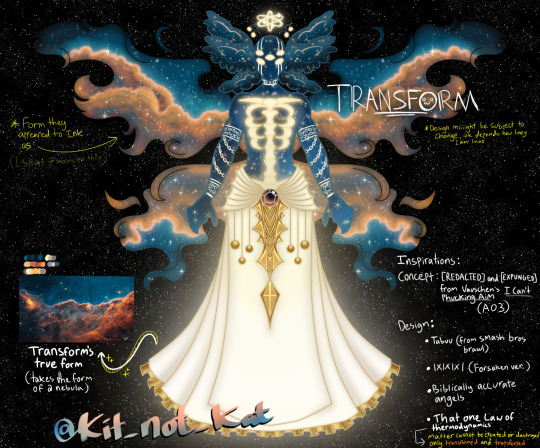
Lemme break down their role + design stuffs for ya
Lore Significance:
• Transform (or Transformation if you prefer) is an eldritch being that resides on a higher plane of existence. They're a physical embodiment of energy transformations (think chemistry).
• After Ink punched a hole in the omniverse (referring to this post; specifically the 2nd paragraph), he basically got sucked out of the entire UTMV as a whole and landed in the space between worlds where he's discovered by Transform & Transfer (soon to be designed!)
• Basically, the two entities are the ones that reshaped Ink into his inphernal form and released him into the wild for reasons I have yet to come up with since I feel the two are purely neutral entities (don't harbor any malice or need for entertainment) being based off that one thermodynamics law
Design Inspirations:
• The concept for Transform (and Transfer) is inspired by [REDACTED] and [EXPUNGED] from @/vauschen-art's I Can't Phucking Aim
• As for actual visual design, the inspirations I drew from were This Specific Picture Of A Nebula, Tabuu (Smash Bros Brawl), 1x1x1x1 (Forsaken's version), and Biblically accurate angels :3
Fun Facts:
• Transform is Genderfluid
• She can take any shape. It's just that he likes the celestial look– makes em feel important. Between them and Transfer, they're the more outspoken (and flashy) one, often choosing bright, extravagant, and more solid forms ublike Transform who'd probably appear in either their true form (nebula) or more of an abstract one
• Transform likes to...reshape things when given the chance. It's part of their nature. Y’know how artists see a piece of paper and IMMEDIATELY statt doodling on it? Yeah, that's basically Transform with anything she can get his hands on. Good thing not too many living beings pass through the in-between.
2 notes
·
View notes
Text
Zoomposium with Prof. Dr. Arieh Ben-Naim: "Demystifying Entropy"

Information about the person and his scientific work
In another installment of our "Zoomposium series" on the topic of "Physics and its limits", my colleague Axel Stöcker from the "Blog of Big Questions" and I had the opportunity to conduct an interview with the renowned Israeli physical chemist Prof. Dr. Arieh Ben-Naim on the exciting topic of "Demystifying entropy".
Arieh, who was born on July 11, 1934, held a chair in physical chemistry at the Hebrew University of Jerusalem for over 40 years, with his main field of research being the theory of the structure of water, aqueous solutions and hydrophobic-hydrophilic interactions. He has been mainly concerned with theoretical and experimental aspects of the general theory of liquids and solutions. In recent years, he has advocated the use of information theory to better understand and advance statistical mechanics and #thermodynamics.
In this context, he has also worked intensively on the question of the nature and underlying principle of the phenomenon of "entropy", which he has published in numerous popular science books that are often quoted but also controversially discussed.
The basic tenor of all his publications and lectures is that we need a new basic understanding of the phenomenon of entropy. In Arieh's view, entropy, which originally stems from the laws of thermodynamics and in particular the second law of thermodynamics, has been misused and incorrectly applied as a concept to other areas of physics, biology and everyday life.
In this respect, it was finally time (bon mot) to ask the author himself about his ground-breaking theses, which cast a different light on the phenomenon of entropy or, perhaps better said, bring entropy back to its place of origin.
The interview we conducted with him is in English.
Find out more at: https://philosophies.de/index.php/2024/02/22/entzauberung-der-entropie/
or: https://youtu.be/Km88EreH4A8
4 notes
·
View notes
Text
Physics Friday #7: It's getting hot in here! - An explanation of Temperature, Entropy, and Heat
THE PEOPLE HAVE SPOKEN. This one was decided by poll. The E = mc^2 post will happen sometime later in the future
Preamble: Thermodynamic Systems
Education level: High School (Y11/12)
Topic: Statistical Mechanics, Thermodynamics (Physics)
You'll hear the word system being used a lot ... what does that mean? Basically a thermodynamic system is a collection of things that we think affect each other.
A container of gas is a system as the particles of gas all interact with each other.
The planet is a system because we, and all life/particles on earth all interact together.
Often, when dealing with thermodynamic systems we differentiate between open, closed, and isolated systems.
An open system is where both the particles and energy contained inside the system interact outside the system. Closed systems only allow energy to enter and exit the system (usually via a "reservoir").
We will focus mainly on isolated systems, where nothing enters or exits the system at all. Unless if we physically change what counts as the "system".
Now imagine we have a system, say, a container of gas. This container will have a temperature, pressure, volume, density, etc.
Let's make an identical copy of this container and then combine it with it's duplicate.
What happens to the temperature? Well it stays the same. Whenever you combine two objects of the same temperature they stay the same. If you pour a pot of 20 C water into another pot of 20 C water, no temperature change occurs.
The same occurs with pressure and density. While there are physically more particles in the system, the volume has also increased.
This makes things like Temperature, Pressure, and Density intensive properties of a system - they don't change when you combine systems with copies of itself. They act more like averages.
However, duplicating a system and combining it with itself causes the volume to double, it also doubles the amount of 'stuff' inside the system.
Thus things like volume are called intensive, as they appear to be altered by count and size, they act more like proportional values.
This is important in both understanding heat and temperature. The energy of a system is an intensive property, whereas temperature is intensive.
Temperature appears to be a sort of average of thermal energy, which is how we can analyse it - but this only works in the case of gasses, which isn't universal. It's useful to use a more abstract definition of temperature.
Heat, on the other hand, is much more real. It is concerned with the amount of energy transferred cased by a change in temperature. This change is driven by the second law of thermodynamics, which requires a maximisation of entropy.
But instead of tackling this from a high-end perspective, let's jump into the nitty-gritty ...
Microstates and Macrostates
The best way we can demonstrate the concept of Entropy is via the analogy of a messy room:
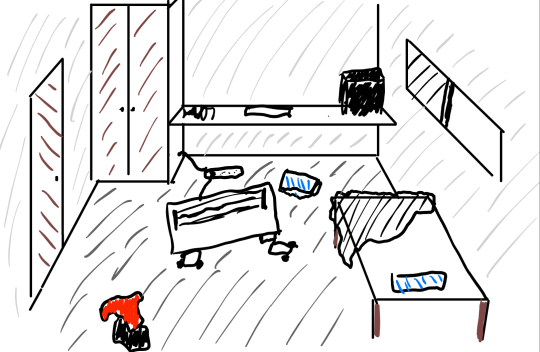
We can create a macrostate of the room by describing the room:
There's a shirt on the floor
The bed is unmade
There is a heater in the centre
The heater is broken
Note how in this macrostate, we can have several possible arrangements that describe the same macrostate. For example, the shirt on the floor could be red, blue, black, green.
A microstate of the room is a specific arrangement of items, to the maximum specificity we require.
For example the shirt must be green, the right heater leg is broken. If we care about even more specificity we could say a microstate of the system is:
Atom 1 is Hydrogen in position (0, 0, 0)
Atom 2 is Carbon in position (1, 0, 0)
etc.
Effectively, a macrostate is a more general description of a system, while a microstate is a specific iteration of a system.
A microstate is considered attached to a macrostate if the conditions of the macrostate are required. "Dave is wearing a shirt" and "Dave is wearing a red shirt" can both be true, but it's clear that if Dave is wearing a red shirt, he is also wearing a shirt.
What Entropy Actually is (by Definition)
The multiplicity of a microstate is the total amount of microstates attached to it. It is basically a "count" of the total permutations given the restrictions.
We give the multiplicity an algebraic number Ω.
What we define entropy as is the natural logarithm of Ω.
S = k ln Ω
Where k is Boltzmann's constant, to give the entropy units. The reason why we take the logarithm is:
Combinatorics often involve factorials and exponents a.k.a. big numbers, so we use the log function to cut it down to size
When you combine a system with a macrostate of Ω=X with a macrostate of Ω=Y, the total multiplicity is X × Y. So this logarithm makes Entropy extensive
So that's what Entropy is, a measure of the amount of possible rearrangements of a system given a set of preconditions.
Order and Chaos
So how do we end up with the popular notion that Entropy is a measure of chaos, well, consider a sand castle,

Image Credit: Wall Street Journal
A sand castle, compared the surrounding beach, is a very specific structure. It requires specific arrangements of sand particles in order to form a proper structure.
This is opposed to the beach, where any loose arrangement of sand particles can be considered a 'beach'.
In this scenario, the castle has a very low multiplicity, because the macrostate of 'sandcastle' requires a very restrictive set of microstates. Whereas a sand dune has a very large set of possible microstates.
In this way, we can see how the 'order' and 'structure' of the sand castle results in a low-entropy system.
However this doesn't explain how we can get such complex systems if energy is always meant to increase. Like how can life exist if the universe intends to make things a mess of particles, AND the universe started as a mess of particles.
The consideration to make, as we'll see, is that chaos is not the full picture, large amounts of energy can be turned into making entropy lower.
Energy Macrostates
There's still a problem with our definition. Consider two macrostates:
The room exists
Atom 1 is Hydrogen in position (0, 0, 0), Atom 2 is Carbon in position (1, 0, 0), etc.
Macrostate one has a multiplicity so large it might as well be infinite, and is so general it encapsulates all possible states of the system.
Macrostate two is so specific that it only has a multiplicity of one.
Clearly we need some standard to set macrostates to.
What we do is that we define a macrostate by one single parameter: the amount of thermal energy in the system. We can also include things like volume or the amount of particles etc. But for now, a macrostate corresponds to a specific energy of the system.
This means that the multiplicity becomes a function of thermal energy, U.
S(U) = k ln Ω(U)
The Second Law of Thermodynamics
Let's consider a system which is determined by a bunch of flipped coins, say, 10 flipped coins.
H T H T H H H T T H
This may seem like a weird example, but there is a genuine usefulness to this. For example, consider atoms aligned in a magnetic field.
We can define the energy of the system as being a function of the amount of heads we see. Thus an energy macrostate would be "X coins are heads".
Let's now say that every minute, we reset the system. i.e. we flip the coins again and use the new result.
Consider the probability of ending up a certain macrostate every minute. We can use the binomial theorem to calculate this probability:

Here, the column notation gives the choose function, which accounts for duplicates, as we are not concerned with the order in which we get any two tails or heads.
The p to the power of k is the probability of landing a head (50%) to the power of the number of heads we get (k). n-k becomes the number of tails obtained.
The choose function is symmetric, so we end up with equal probabilities with k heads as with k tails.
Let's come up with some scenarios:
There are an equal amount of heads and tails flipped
There is exactly two more heads than tails (i.e. 6-4)
All coins are heads except for one
All coins are heads
And let's see these probabilities:
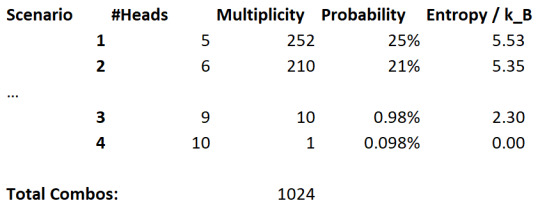
Clearly, it is more likely that we find an equal amount of coins, but all coins being heads is not too unlikely. Also notice that the entropy correlates with probability here. A large entropy is more likely to occur.
Let's now increase the number of coin flips to 1000:

Well, now we can see this probability difference much more clearly. The "all coins are heads" microstate is vanishingly unlikely, and microstates close to maximum entropy are very likely comparatively.
If we keep expanding the amount of flips, we end up pushing the limits of this relationship. And thus we get the tendency for this system to maximise the entropy, simply because it's most likely.
In real life, systems don't suddenly reset and restart. Instead we want to consider a system where every minute, one random coin is selected and then flipped.
Consider a state in maximum entropy undergoing this change. It's going to take an incredibly long amount of time to perform something incredibly unlikely.
But for a state in minimum entropy, any deviation from the norm brings the entropy higher.
Thus the system has the tendency to end up being "trapped" in the higher entropy states.
This is the second law of thermodynamics. It doesn't actually make a statement about a particularly small system. But for small systems we deal with statistics differently. For large systems, we end up ALWAYS seeing a global increase in entropy.
How we get temperature
Temperature is usually defined as the capacity to transfer thermal energy. It sort of acts like a "heat potential" in the same way we have a "gravitational potential" or "electrical potential".
Temperature and Thermal Energy
What is the mathematical meaning of temperature?
Temperature is defined as a rate of change, specifically:

(Apologies for the fucked image formatting)
(Reminder this assumes Entropy is exclusively a function of energy)
The reason we define it as a derivative of entropy as entropy is an emergent property of a system. But thermal energy is something we can personally change.
What this rule means is that a system with a very low temperature will react greatly to minor inputs in energy. A low temperature system thus is really good at drawing energy from outside.
Alternatively, a system with very high temperature will react very slightly to minor inputs in energy.
At the extremes, absolute zero is where any change to the internal energy of the system will cause the system to escape absolute zero. According to the third law of thermodynamics this is where entropy reaches a constant value, because it can't be changed any more after being changed by an infinite amount.
Infinite temperature is where it's effectively impossible to pump more heat into the system, because the system is so resistant to accepting new energy.
Negative Temperature???
Considering our coin-flipping example, let's try and define some numbers. Let's say that the thermal energy of the system is equal to the amount of heads flipped.
This gives us an entropy of:
S ≈ U ln[n/U - 1] + n ln[1 - U/n]
(hopefully this is correct)
The derivative of this is:
dS/dU = ln[n/U - 1] - 2n/(n-U)
Note how this value becomes negative if n is large enough. Implying a negative temperature!
But how is this possible? What does this mean?
Negative temperatures are nothing out of the ordinary actually, they just mean that inputting energy decreases entropy and removing energy increases entropy.
What this means is that a system at a negative temperature, when put in contact with another system, will spontaneously try to dump energy out of itself as it aims to increase entropy.
This actually means that negative temperature is beyond infinite temperature. A fully expanded temperature scale looks like this:
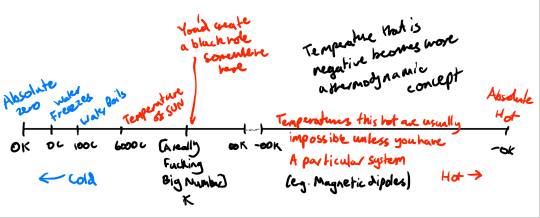
[The Planck temperature is the largest possible temperature that won't create a black hole at 1.4 × 10³² Kelvin]
[Note that 0 K = -273.15 C = -459.67 F and 273.15 K = 0 C = 32 F]
This implies that -0 is sort of the 'absolute hot'. A temperature so hot that the system will desperately try to bleed energy much like the absolute zero system tries to suck in energy.
Heat and the First Law of Thermodynamics
So, what do we do with this information then? How do we actually convert this into something meaningful?
Here, we start to pull in the first law of thermodynamics, which originates with the thermodynamic identity:
dU = T dS - P dV
Note that these dx parts just mean a 'tiny change' in that variable. Here, U is expanded to include situations where the thermal energy of the system has to include things like compression/expansion work done to the system.
This identity gives us the first law:
dU = Q - W
Where Q, the heat energy of the system is re-defined as being dS/dQ = 1/T.
And W, the work (mechanical) energy of the system is defined as being dU/dV.
Both heat and work describe the changes to the energy of the system. Heating a system means you are inputting an energy Q.
If no energy is entering or exiting the system, then we know that any work that is being applied must be matched by an equal change in heat energy.
Since we managed to phrase temperature as a function of thermal energy, we can now develop what's known as an equation of state of the system.
For an ideal gas made of only hydrogen, we have an energy:
U = 3/2 NkT
Where N is the number of particles and k is the boltzmann constant.
We can also define another equation of state for an ideal gas:
PV = NkT
Which is the ideal gas law.
So what is heat then?
Q is the change of heat energy in a system, whereas U is the total thermal energy.
From the ideal gas equation of state, the thermal energy is proportional to temperature. In most cases, we can often express thermal energy as being temperature scaled to size.
Thermal energy is strange. Unlike other classical forms of energy, it can be difficult to classify it as potential or kinetic.
It's a form of kinetic energy as U relies on the movement of particles and packets within the system.
It's a form of potential energy, as it has the potential to transfer it's energy to others.
Generally, the idea that thermal energy is related to temperature is related to the 'speed' at which particles move is not too far off. In fact, we often relate:
1/2 m v^2 = 3/2 N k T
When performing calculations, as it's generally useful.
Of course, temperature, as aforementioned, is a sort of potential describing the potential energy (that can be transferred) per particle.
Heat, then effectively, is the transfer of thermal energy caused by differences in temperature. Generally, we quantify the ability for a system to give off heat using it's heat capacity - note that this is different from temperature.
Temperature is about how much the system wants to give off energy, whereas heat capacity is how well it's able to do that. Heat aims to account for both.
Conclusion
This post honestly was a much nicer write-up. And I'd say the same about E = mc^2. The main reason why is because I already know about this stuff, I was taught about it all 1-4 years ago in high school or university.
My computer is busted, so I'm using a different device to work on this. And because of that I do not have access to my notes. So I don't actually know what I have planned for next week. I think I might decide to override it anyways with something else. Maybe the E = mc^2 one.
As always, feedback is very welcome. Especially because this topic is one I should be knowledgeable about at this point.
Don't forget to SMASH that subscribe button so I can continue to LARP as a youtuber. It's actually strangely fun saying "smash the like button" - but I digress. It doesn't ultimately matter if you wanna follow idc, some people just don't like this stuff weekly.
#stem#academics#physics friday#physics#stemblr#science#thermodynamics#temperature#entropy#statistical mechanics
43 notes
·
View notes
Text
Thermodynamics and Its Relevance to Mechanical Engineering
There are so many colleges but Arya College of Engineering & I.T. is the best college in Jaipur Rajasthan which provides information about thermodynamics it is a fundamental branch of mechanical engineering that deals with the principles governing energy, heat, and work. It is essential for understanding how energy is transformed and utilized in various systems, making it a cornerstone of mechanical engineering applications. This exploration of thermodynamics will cover its basic principles, laws, applications, and significance in mechanical engineering.
Fundamental Principles of Thermodynamics
Thermodynamics is primarily concerned with the relationships between heat and other forms of energy. It is governed by several key laws:
1. Zeroth Law of Thermodynamics: This law establishes the concept of temperature and thermal equilibrium. It states that if two systems are in thermal equilibrium with a third system, they are also in thermal equilibrium with each other.
2. First Law of Thermodynamics: Often referred to as the law of energy conservation, it states that energy cannot be created or destroyed, only transformed. Mathematically, it can be expressed as:
ΔU=Q−WΔU=Q−W
where ΔUΔU is the change in internal energy, QQ is the heat added to the system, and WW is the work done by the system.
3. Second Law of Thermodynamics: This law introduces the concept of entropy, indicating that energy transformations are not 100% efficient and that heat cannot spontaneously flow from a colder to a hotter object. It establishes the direction of natural processes and the limits of energy conversion.
4. Third Law of Thermodynamics: This law states that as a system approaches absolute zero, its entropy approaches a constant, usually zero. It provides a basis for defining absolute entropy.
Applications of Thermodynamics in Mechanical Engineering
Thermodynamics principles are applied in various areas of mechanical engineering, including:
1. Power Generation: Thermodynamics is crucial in the design and analysis of power plants, such as steam power plants, gas turbines, and internal combustion engines. It helps optimize the efficiency of energy conversion processes.
2. Refrigeration and Air Conditioning: The principles of thermodynamics are used to design and analyze refrigeration and air conditioning systems, ensuring efficient heat transfer and maintaining desired temperatures.
3. Fluid Mechanics: Thermodynamics is closely related to fluid mechanics, as it helps understand the behavior of fluids under different conditions, such as pressure and temperature changes.
4. Heat Transfer: Thermodynamics provides the foundation for understanding heat transfer mechanisms, including conduction, convection, and radiation, which are essential in the design of heat exchangers, boilers, and other thermal systems.
5. Combustion: Thermodynamics is used to analyze combustion processes, which are crucial in the design of internal combustion engines, gas turbines, and other systems that rely on burning fuels.
Significance of Thermodynamics in Mechanical Engineering
Thermodynamics is a fundamental aspect of mechanical engineering for several reasons:
1. It provides a framework for understanding energy transformations: Thermodynamics helps engineers analyze and optimize the conversion of energy from one form to another, ensuring efficient and effective systems.
2. It enables the design of thermal systems: Thermodynamics is essential in designing and analyzing thermal systems, such as power plants, refrigeration units, and HVAC systems, ensuring their proper functioning and efficiency.
3. It helps in material selection: Thermodynamics provides insights into the behavior of materials under different conditions, allowing engineers to select appropriate materials for specific applications.
4. It contributes to sustainability: By understanding the principles of energy conversion and the limitations imposed by the laws of thermodynamics, engineers can design more sustainable and environmentally friendly systems.
In conclusion, thermodynamics is a crucial aspect of mechanical engineering, providing a fundamental understanding of energy transformations and enabling the design of efficient and effective systems. Its applications span various domains, from power generation to refrigeration and air conditioning, making it an essential tool for mechanical engineers in their pursuit of innovation and progress.
5 notes
·
View notes
Note
*puts on a diffirent costume*
Trick or treat?
😊
(ask box trick-or-treat)
One of my favourite fic concepts on my Sticky Note of Ideas is called, simply, "Tyelpe and thermodynamics". The basic idea: the Three Rings were basically an attempt to counteract the Second Law of Thermodynamics, right. also in arda you have to assume that entropy/decay etc were invented by Morgoth. So Celebrimbor, a child when he left Valinor, spends all his life trying to recreate heaven as he remembers it in Marred Middle-earth; and of course Sauron, whose whole Thing is about order, will understand how to appeal to him! Except Sauron would rather dominate the world, and make it a dead sterile thing, than let it slip out of his control, and Celebrimbor only ever wanted to preserve its beauty. Also picture him re-embodied in Valinor and realising at last that everything changes, and entropy is inevitable, and the idealised paradise of his memory is different too now. Look I just think I should get to put a bunch of equations in a fic as a treat.
#asks#springfountain#ask game#my writing#also I am SURE I can tie this into my headcanon that ainur cause relativistic time dilation#all the physics in one fic is the goal here
22 notes
·
View notes